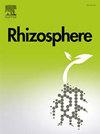Anti-tyrosinase activity of Hymenaea martiana is increased by arbuscular mycorrhizal fungi inoculated into the rhizosphere
IF 3.5
3区 生物学
Q1 PLANT SCIENCES
引用次数: 0
Abstract
Arbuscular mycorrhizal fungi (AMF) modulate phytochemical synthesis, while their effects on plant anti-tyrosinase activity (ATY) have not been elucidated. Improving this bioactivity is important due to the high demand for natural anti-melanogenics. The study aimed to verify whether the ATY of foliar extracts from Hymenaea martiana Hayne (Fabaceae) cultivated with AMF is enhanced and whether there is a correlation between antioxidant activity and metabolite production. Hymenaea martiana is leguminous tree endemic to Brazil and Paraguay known for rhamnosides isolated from its bark.Thus, H. martiana seedlings were inoculated or not with Acaulospora longula, Gigaspora albida, and Entrophospora etunicata. Seedlings associated with G. albida and E. etunicata exhibited a 43 % increase in foliar ATY and higher flavonoids concentrations, compared to non-inoculated plants. Inoculating H. martiana with G. albida and E. etunicata is recommended to produce a phytomass with greater whitening potential. For multifunctional benefits, including enhanced antioxidant and anti-tyrosinase actions of the phytomass, inoculation specifically with E. etunicata is recommended. This is the first report of a mycorrhization-induced improvement in plant ATY.

将丛枝菌根真菌接种到根际后,可提高黑膜菌的抗酪氨酸酶活性
丛枝菌根真菌(AMF)调节植物化学合成,但其对植物抗酪氨酸酶活性(ATY)的影响尚未阐明。由于对天然抗黑素的高需求,提高这种生物活性是很重要的。本研究旨在验证经AMF培养的马提亚膜(Hymenaea martiana Hayne)叶提取物的抗氧化活性是否增强,以及抗氧化活性与代谢物产量之间是否存在相关性。马提亚膜属豆科树木,巴西和巴拉圭特有,以从树皮中分离出的鼠李糖苷而闻名。由此可见,红麻幼苗接种或不接种长茎孢子虫、褐毛孢子虫和弓形孢子虫均可。与未接种的植株相比,与合欢和黄酮相关的幼苗叶片ATY增加了43%,黄酮浓度更高。建议将马氏金盏花与白刺金盏花和黄刺金盏花接种,产生具有更大增白潜力的植物群。考虑到多种功能的益处,包括增强植物的抗氧化和抗酪氨酸酶作用,建议专门接种弓形虫。这是首次报道菌根诱导植物ATY的改善。
本文章由计算机程序翻译,如有差异,请以英文原文为准。
求助全文
约1分钟内获得全文
求助全文
来源期刊

Rhizosphere
Agricultural and Biological Sciences-Agronomy and Crop Science
CiteScore
5.70
自引率
8.10%
发文量
155
审稿时长
29 days
期刊介绍:
Rhizosphere aims to advance the frontier of our understanding of plant-soil interactions. Rhizosphere is a multidisciplinary journal that publishes research on the interactions between plant roots, soil organisms, nutrients, and water. Except carbon fixation by photosynthesis, plants obtain all other elements primarily from soil through roots.
We are beginning to understand how communications at the rhizosphere, with soil organisms and other plant species, affect root exudates and nutrient uptake. This rapidly evolving subject utilizes molecular biology and genomic tools, food web or community structure manipulations, high performance liquid chromatography, isotopic analysis, diverse spectroscopic analytics, tomography and other microscopy, complex statistical and modeling tools.
 求助内容:
求助内容: 应助结果提醒方式:
应助结果提醒方式:


